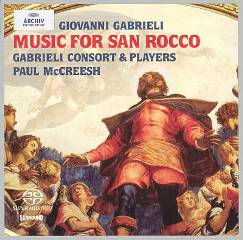Giovanni Gabrieli - Music For San Rocco (1996)
Giovanni Gabrieli - Music For San Rocco (1996)

Giovanni GABRIELI 1. Fuga sul IX Tono [2:34] 2. In Ecclesiis a 14 (C 78) [7:26] 3. Sonata No.19 à 15 (C212) - Sonata No.19 à 15 (C212) [5:09] 4. Suscipe, clementissime Deus à 12 (C70) - Suscipe, clementissime Deus à 12 (C70) [4:55] 5. Canzona No.14 à 10 (C207) - Canzona No.14 à 10 (C207) [2:51] 6. Buccinate in neomenia tuba à 19 (C84) - Buccinate in neomenia tuba à 19 (C84) [3:38] 7. Intonazione del nono tono (C247) - Intonazione del nono tono (C247) [0:40] 8. Domine Deus Meus a 6 (C 127) [7:52] Bartolomeo BARBARINO 9. Audi, Dulcis Amica Mea [3:45] Giovanni GABRIELI 10. Sonata con tre violini (XXI from Canzoni et Sonate, 1615) [3:51] Bartolomeo BARBARINO 11. Ardens est cor meum [2:44] Giovanni GABRIELI 12. Timor et tremor, motet for 6 voices (1615) [6:44] 13. Intonazione del duodecimo tono, for organ, C. 250 [0:33] 14. Jubilate Deo, motet for 10 voices [4:40] 15. Sonata No. 18, for 14 parts [6:14] 16. Misericordia tua, Domine, motet for 12 voices [4:15] 17. Sonata No. 20, for 22 parts [6:22] 18. Magnificat for 33 voices (incomplete) [5:55] Gabrieli Consort Timothy Roberts – organ Fred Jacobs, Paula Chateauneuf – chitarrone David Hurley – falsetto Paul McCreesh - conductor
The words ‘Venice’ and ‘splendour’ were simply made to go together and are certainly brought together in the latest recording by the Gabrieli Consort and Players entitled “Music for San Rocco”. The CD is dedicated to an exploration of the vocal and instrumental music of Giovanni Gabrieli, who composed many works for the Confraternity of San Rocco, with just a couple of contributions from the otherwise unknown Bartolomeo Barbarino. He was a virtuoso falsettist who is thought to have performed at the sumptuous feast of music held in honour of St Roch in 1608 of which a remarkably full eye-witness account survives among Coryats Crudities (1611).
Indeed, Paul McCreesh and his team of advisers have taken Thomas Coryat’s description of the 1608 festivities as the starting-point for this concert programme (the music described by Coryat may have formed part of a Vespers service – it’s not clear) which was performed – and videoed – in the magnificent Scuola Grande di San Rocco, famous for its sequence of paintings by Tintoretto. The visual sumptuousness of the interior of the Scuola is well captured on the video, although it suffers from the perennial problem of filmed concerts: a too-rapid sequence of camera shots. I’d much rather the camera lingered longer on the paintings without jumping every few seconds from a soloist’s profile to a sackbut player’s embouchure to a theorbist’s fingers. Nevertheless, the close-ups of the Tintorettos (identified in the booklet provided with the video) to the accompaniment of Gabrieli’s music are certainly an aesthetic feast which surely helps to recapture something of Coryat’s experience. (On the video, art historian Edwin Mullins eloquently adds his thoughts on Tintoretto, and Paul McCreesh justifies, against a lot of background tourist-type noises, the choice of music for his reconstruction of the event.) You will, I suspect, want to listen to the music on your CD player to get the best sound quality (even with a stereo television the results were disappointingly boxy), although it takes skilful manipulation of the remote control to synchronize the video and CD players.
The programme explores a wide range of works by Gabrieli, from the more intimate motets with organ accompaniment right through the spectrum to the extraordinary 33-part Magnificat reconstructed for the occasion by Hugh Keyte. The sheer magnificence of the sound of massed cornetts and sackbuts, blending so harmoniously with the voices, clearly struck Coryat, and is equally irresistible the best part of four centuries later. This is where the Gabrieli Consort and Players came in some years ago when one could only wonder at McCreesh’s logistical abilities in bringing together the required number of chamber organs and so on (“A Venetian Coronation, 1595”, Virgin Classics, 5/90).
The group have, of course, gone from strength to strength, and have explored a wide range of repertory, but they clearly retain a strong affinity with Gabrieli’s music. The singing and playing are quite superb, securely and compellingly flamboyant. It’s difficult to single out individuals from such a high-powered and well-integrated team, but I think I must mention David Hurley who sings the remarkable solo motets by Barbarino with great poise. The cornetts and sackbuts really come into their own in the purely instrumental items such as Gabrieli’s Sonata XVIII but their contribution throughout is vital to the success of the recording.
It is hard to imagine this fine recording of Gabrieli’s music being superseded for some time to come; the video is a luxurious, and very welcome, bonus. For the sheer splendour of the music, and the excellence of the performances, this recording is a must, a real five-star achievement. --Gramophone Magazine, arkivmusic.com
download: uploaded anonfiles yandex 4shared solidfiles mediafire mega filecloudio








